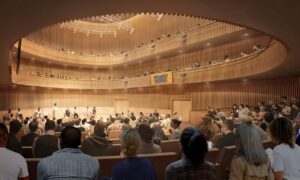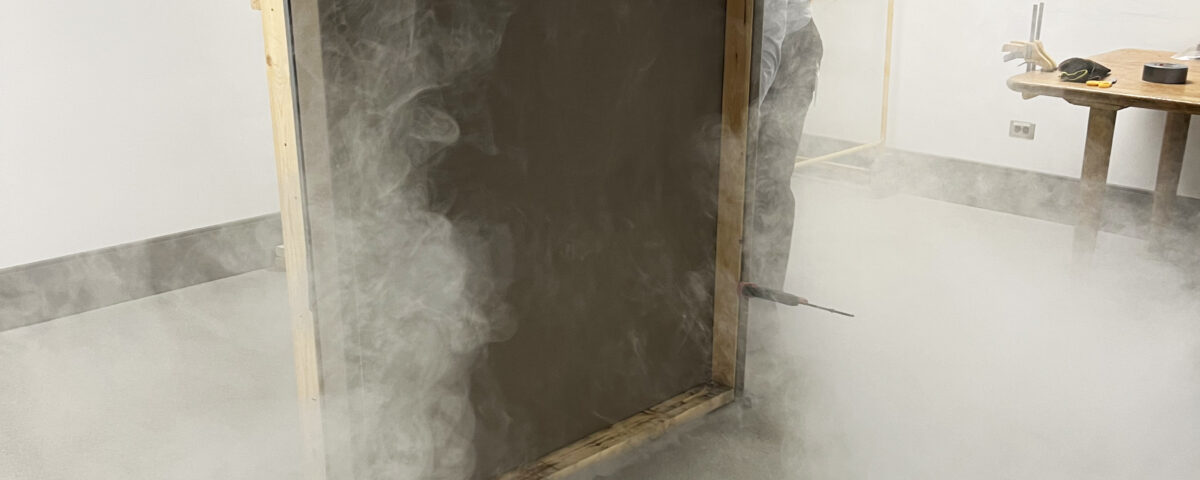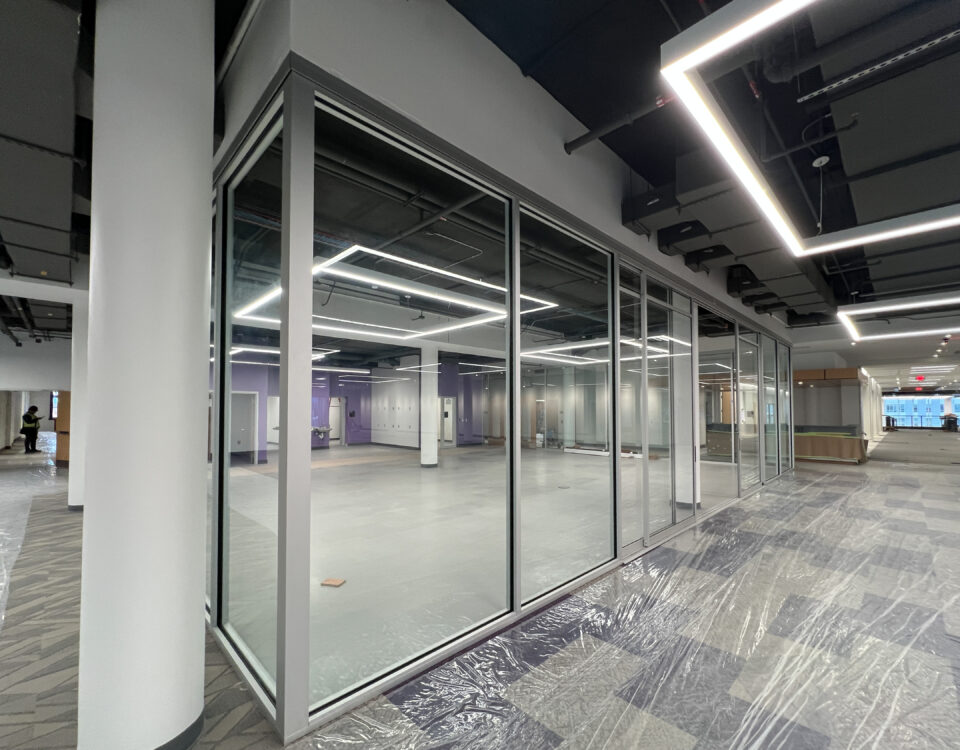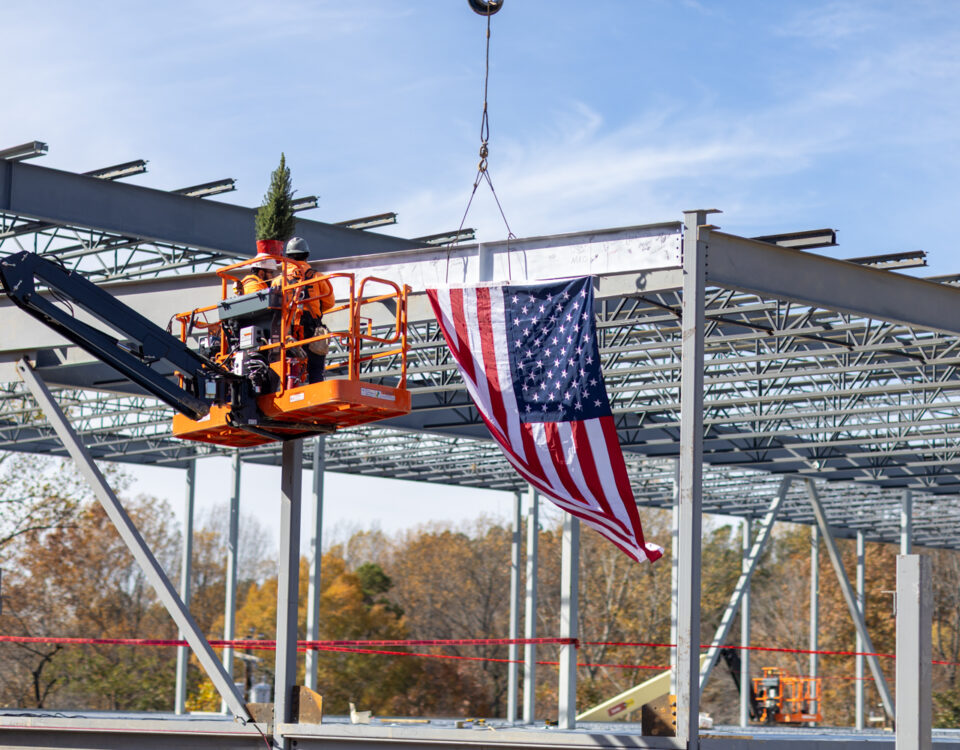Choosing the right HVAC system is critical, and displacement ventilation can be an innovative solution for a variety of project types. Determining the best system type for any project requires holistic consideration of space use, building geometry, sustainability goals, and budget. Displacement ventilation is a specialized HVAC system that, in the right application, can check each of these boxes when other system types may not. Unlike traditional mixed-air HVAC systems, which require the entire air volume in a space to be mixed and circulated, displacement ventilation utilizes thermal plumes and stratification to lift warm air and particulates up and out of the occupied breathing zone, leaving only cool, fresh air where the occupants are. Air is supplied close to the floor at low velocity to allow the cool air to pool at the floor. When the cool air reaches a heat source, such as a person, the buoyancy of warm air causes it to rise and cool air is drawn up from below. Since there is no need to mix air in the space, supply velocities can be very low, resulting in a quiet system that can go nearly unnoticed. These features make displacement ventilation a great option for spaces with high ceilings, low acoustic requirements, and many occupants.
Karsh IOD Design Features
 The Karsh Institute of Democracy (IOD) is a 70,000 SF academic building located on grounds at the University of Virginia. It features a spacious auditorium ideally suited for a displacement ventilation system. The main auditorium has seating for 400 across the main level and the two balconies around the upper perimeter. The central volume of the auditorium allows for the warm air and any particulates to be lifted to the ceiling, where it can be returned to the air handling unit. Cool air is supplied low to the floor, where the occupants are. Designed to host high-profile presentations and events, the auditorium needed to be carefully designed to focus on the stage, not the comfort or ambient noise in the space.
The Karsh Institute of Democracy (IOD) is a 70,000 SF academic building located on grounds at the University of Virginia. It features a spacious auditorium ideally suited for a displacement ventilation system. The main auditorium has seating for 400 across the main level and the two balconies around the upper perimeter. The central volume of the auditorium allows for the warm air and any particulates to be lifted to the ceiling, where it can be returned to the air handling unit. Cool air is supplied low to the floor, where the occupants are. Designed to host high-profile presentations and events, the auditorium needed to be carefully designed to focus on the stage, not the comfort or ambient noise in the space.
The tiered auditorium seating makes the space a prime candidate for an under-floor plenum system, with floor-mounted diffusers, that distributes air beneath the seats. The displacement system supplies air at extremely low velocities and warmer temperatures. These two features are key to thermal comfort and acoustics. The low velocity eliminates noise issues like whistling or rumbling (that can be heard when air is supplied at higher velocities) while maintaining sound levels below the NC-25 goal, and preventing drafts felt by occupants. Warmer supply air ensures that those seated above the diffusers experience subtle air movement while enjoying the benefits of both thermal comfort and improved air quality.
In areas where an underfloor plenum could not be used, such as at the stage or around the balconies, air is distributed from the perimeter walls through sidewall diffusers specifically designed for displacement ventilation systems. These diffusers are hidden behind wood slat wall assemblies, allowing them to blend with the architectural design while effectively distributing air. The devices are custom and underwent extensive product testing—including flow, smoke, and computational fluid dynamics (CFD) tests—to ensure they not only integrate seamlessly with the design but also deliver proper mechanical performance.
Design Process
To design the system, we began by calculating the necessary air volume required to properly condition the space and the amount of required outside air. The displacement system effectively supplies fresh air to the breathing zone. So effective, in fact, that 20% less outside air is required compared to a traditional mixed air system. This is due to cool air from below being drawn directly toward the occupants and forcing warm air and air particulates out of the breathing zone. Outside air conditioning can be particularly energy intensive. Minimizing the outdoor air requirements while providing fresh, healthy air is essential.
A computational fluid dynamics (CFD) analysis helped assess the thermal plumes and the air stratification. The occupants, lighting, and equipment were modeled to ensure adequate air conditioning in the auditorium. This allowed us to visualize how the temperature varied for each seat in the auditorium. Since the displacement ventilation system requires air stratification, we needed to ensure that the upper balconies were not significantly warmer than the levels below. It also allowed us to visualize the thermal plumes and optimize the layout of the supply diffusers so that air is circulated up through the open central volume to the ceiling.
The custom diffuser installation was tested at the same time as the CFD. Since the air is distributed at such a low velocity, the fabric backing on the wood slat wall must be tested with the diffuser to ensure air flowed into the space. Price Industries invited us up to their facility, in Winnipeg, Canada, to view and assist in the product testing. While there, we reviewed the testing results and iterated the mockup to closely replicate the installation at the Karsh IOD. The architect provided several different fabric options for the testing. A wall mockup was created with each of the fabrics to see which was the best option. Various measurements such as flow velocity, flow rate, and pressure drop were measured. During the testing process, smoke was injected into the airstream to visualize the flow through the construction and find any gaps for potential air leakage. The testing showed a distinct performance difference in the fabrics and helped create the diffuser’s installation detail.
Ultimately, the displacement ventilation system at the Karsh Institute of Democracy exemplifies the effective blend of occupant comfort, energy efficiency, and design integrity. With thorough analysis and custom testing, it highlights how innovative HVAC solutions can meet sustainability and comfort goals, setting a standard for future environmentally responsible projects.





